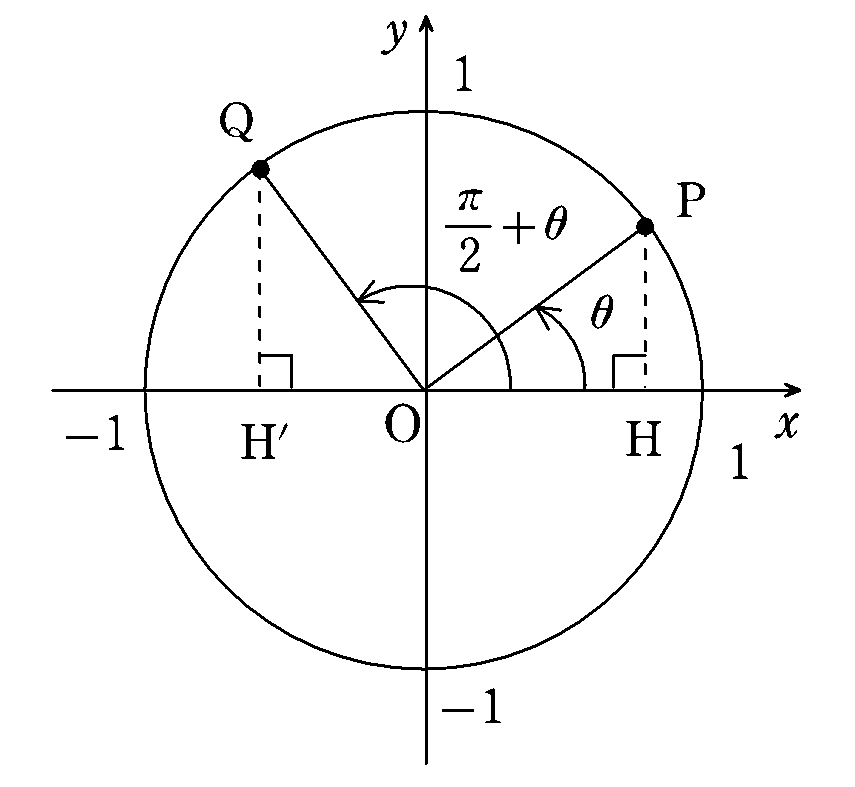
社会人のための学び直し数学【高校数学三角関数編その6】
6.加法定理②
$${\mathrm{sin}x}$$ の加法定理を考えます。
前回は $${\mathrm{cos}x}$$ の加法定理
$${\mathrm{cos}(α-β)=\mathrm{cos}α\mathrm{cos}β+\mathrm{sin}α\mathrm{sin}β}$$ ―(☆)
から始めましたが,今回もこの式から始めます。
まずは準備から。

図 6-1 で動径 $${\mathrm{OP}}$$ および $${\mathrm{OQ}}$$ と $${x}$$ 軸の正の向きとのなす角をそれぞれ $${θ}$$,$${\cfrac{π}{2}+θ}$$ とし,円周上の点 $${\mathrm{P}}$$ および $${\mathrm{Q}}$$ から $${x}$$ 軸に下した垂線の足をそれぞれ $${\mathrm{H}}$$,$${\mathrm{H'}}$$ とします。
このとき点 $${\mathrm{P}}$$ の座標は
$${(\mathrm{cos}θ,\mathrm{sin}θ)}$$
点 $${\mathrm{Q}}$$ の座標は
$${\left(\mathrm{cos}(\frac{π}{2}+θ),\mathrm{sin}(\frac{π}{2}+θ)\right)}$$
となります。また,$${△\mathrm{OPH}}$$ は $${\mathrm{OP}}$$ を斜辺とする $${∠\mathrm{POH}=θ}$$ の直角三角形で,$${y}$$ 軸の正の向きと動径 $${\mathrm{OQ}}$$ のなす角が $${θ}$$ であることに注意すれば,$${△\mathrm{OQH'}}$$ は $${\mathrm{OQ}}$$ を斜辺とする $${∠\mathrm{OQH'}=θ}$$ の直角三角形です。もちろん $${△\mathrm{OPH}}$$ と $${△\mathrm{OQH'}}$$ は合同な三角形です。すると,対応する辺の長さと,点 $${\mathrm{P}}$$,点 $${\mathrm{Q}}$$ の座標を見比べることで
$${\mathrm{cos}(\frac{π}{2}+θ)=-\mathrm{sin}θ}$$
$${\mathrm{sin}(\frac{π}{2}+θ)=\mathrm{cos}θ}$$
の成り立ちが確認できます。そして,点 $${\mathrm{P}}$$,点 $${\mathrm{Q}}$$ が円周上のどこにあっても $${∠\mathrm{POQ}=\cfrac{π}{2}}$$ が成り立つ限り,図 6-1 と同等の位置関係が動径 $${\mathrm{OP}}$$ および $${\mathrm{OQ}}$$ の間に見出せるので
$${\mathrm{cos}(\frac{π}{2}+θ)=-\mathrm{sin}θ}$$
$${\mathrm{sin}(\frac{π}{2}+θ)=\mathrm{cos}θ}$$
は一般に成り立ちます。
準備終了。
加法定理 (☆) はどんな角 $${α,β}$$ に対しても成り立つので $${α}$$→$${\cfrac{π}{2}+α}$$ と書き換え,2 つの角 $${\cfrac{π}{2}+α}$$,$${β}$$ に対して書いてみると,
$${\mathrm{cos}(\frac{π}{2}+α-β)=\mathrm{cos}(\frac{π}{2}+α)\mathrm{cos}β+\mathrm{sin}(\frac{π}{2}+α)\mathrm{sin}β}$$
となります。すると,準備で説明した式を使って
$${\mathrm{cos}(\frac{π}{2}+α-β)=\mathrm{cos}\left(\frac{π}{2}+(α-β)\right)=-\mathrm{sin}(α-β)}$$
$${\mathrm{cos}(\frac{π}{2}+α)=-\mathrm{sin}α,\mathrm{sin}(\frac{π}{2}+α)=\mathrm{cos}α}$$
であるから
$${-\mathrm{sin}(α-β)=-\mathrm{sin}α\mathrm{cos}β+\mathrm{cos}α\mathrm{sin}β}$$
より
$${\mathrm{sin}(α-β)=\mathrm{sin}α\mathrm{cos}β-\mathrm{cos}α\mathrm{sin}β}$$
が導けます。
また,この式で $${β}$$ → $${-β}$$ と書き換え,
$${\mathrm{cos}(-β)=\mathrm{cos}β,\mathrm{sin}(-β)=-\mathrm{sin}β}$$
を使うと
$${\mathrm{sin}(α+β)=\mathrm{sin}α\mathrm{cos}β+\mathrm{cos}α\mathrm{sin}β}$$
も導けます。
結局,$${\mathrm{cos}x}$$,$${\mathrm{sin}x}$$ の加法定理は
$${\mathrm{cos}(α-β)=\mathrm{cos}α\mathrm{cos}β+\mathrm{sin}α\mathrm{sin}β}$$ ー①
$${\mathrm{cos}(α+β)=\mathrm{cos}α\mathrm{cos}β-\mathrm{sin}α\mathrm{sin}β}$$ ―②
$${\mathrm{sin}(α-β)=\mathrm{sin}α\mathrm{cos}β-\mathrm{cos}α\mathrm{sin}β}$$ ―③
$${\mathrm{sin}(α+β)=\mathrm{sin}α\mathrm{cos}β+\mathrm{cos}α\mathrm{sin}β}$$ ―④
の 4 つの式です。
この 4 つの加法定理を使って,三角関数の公式をいくつか作ってみます。
①,③ で $${α=0}$$,$${β=θ}$$ として,$${\mathrm{cos}0=1}$$,$${\mathrm{sin}0=0}$$ を使うと
$${\mathrm{cos}(0-θ)=\mathrm{cos}0\mathrm{cos}θ+\mathrm{sin}0\mathrm{sin}θ=\mathrm{cos}θ}$$
$${\mathrm{sin}(0-θ)=\mathrm{sin}0\mathrm{cos}θ-\mathrm{cos}0\mathrm{sin}θ=-\mathrm{sin}θ}$$
すなわち,$${\mathrm{cos}(-θ)=\mathrm{cos}θ}$$,$${\mathrm{sin}(-θ)=-\mathrm{sin}θ}$$ です。
①,③ で $${α=π}$$,$${β=θ}$$ として,$${\mathrm{cos}π=-1}$$,$${\mathrm{sin}π=0}$$ を使うと
$${\mathrm{cos}(π-θ)=\mathrm{cos}π\mathrm{cos}θ+\mathrm{sin}π\mathrm{sin}θ=-\mathrm{cos}θ}$$
$${\mathrm{sin}(π-θ)=\mathrm{sin}π\mathrm{cos}θ-\mathrm{cos}π\mathrm{sin}θ=\mathrm{sin}θ}$$
すなわち,$${\mathrm{cos}(π-θ)=-\mathrm{cos}θ}$$,$${\mathrm{sin}(π-θ)=\mathrm{sin}θ}$$ です。
②,④ で $${α=π}$$,$${β=θ}$$ として,$${\mathrm{cos}π=-1}$$,$${\mathrm{sin}π=0}$$ を使うと
$${\mathrm{cos}(π+θ)=\mathrm{cos}π\mathrm{cos}θ-\mathrm{sin}π\mathrm{sin}θ=-\mathrm{cos}θ}$$
$${\mathrm{sin}(π+θ)=\mathrm{sin}π\mathrm{cos}θ+\mathrm{cos}π\mathrm{sin}θ=-\mathrm{sin}θ}$$
すなわち,$${\mathrm{cos}(π+θ)=-\mathrm{cos}θ}$$,$${\mathrm{sin}(π+θ)=-\mathrm{sin}θ}$$ です。
②,④ で $${α=\cfrac{π}{2}}$$,$${β=θ}$$ として,$${\mathrm{cos}\cfrac{π}{2}=0}$$,$${\mathrm{sin}\cfrac{π}{2}=1}$$ を使うと
$${\mathrm{cos}(\frac{π}{2}+θ)=\mathrm{cos}\frac{π}{2}\mathrm{cos}θ-\mathrm{sin}\frac{π}{2}\mathrm{sin}θ=-\mathrm{sin}θ}$$
$${\mathrm{sin}(\frac{π}{2}+θ)=\mathrm{sin}\frac{π}{2}\mathrm{cos}θ+\mathrm{cos}\frac{π}{2}\mathrm{sin}θ=\mathrm{cos}θ}$$
すなわち,$${\mathrm{cos}(\frac{π}{2}+θ)=-\mathrm{sin}θ}$$,$${\mathrm{sin}(\frac{π}{2}+θ)=\mathrm{cos}θ}$$ です。
これらは,いままでに図を利用して導いた公式ですが,加法定理を使えば角度を書き換えるだけで導けるのです。
さらに,公式をつくりましょう。
② で $${α=θ}$$,$${β=θ}$$ とすると
$${\mathrm{cos}(θ+θ)=\mathrm{cos}θ\mathrm{cos}θ-\mathrm{sin}θ\mathrm{sin}θ=\mathrm{cos}^2θ-\mathrm{sin}^2θ}$$
すなわち,$${\mathrm{cos}2θ=\mathrm{cos}^2θ-\mathrm{sin}^2θ}$$ です。
ここで,$${\mathrm{sin}^2θ=1-\mathrm{cos}^2θ}$$ あるいは $${\mathrm{cos}^2θ=1-\mathrm{sin}^2θ}$$ であることを使えば
$${\mathrm{cos}2θ=2\mathrm{cos}^2θ-1}$$ または $${\mathrm{cos}2θ=1-2\mathrm{sin}^2θ}$$
となります。これを $${\mathrm{cos}x}$$ の倍角の公式といいます。
④ で $${α=θ}$$,$${β=θ}$$ とすると
$${\mathrm{sin}(θ+θ)=\mathrm{sin}θ\mathrm{cos}θ+\mathrm{cos}θ\mathrm{sin}θ=2\mathrm{sin}θ\mathrm{cos}θ}$$
すなわち,$${\mathrm{sin}2θ=2\mathrm{sin}θ\mathrm{cos}θ}$$ です。これは $${\mathrm{sin}x}$$ の倍角の公式です。
$${\mathrm{cos}x}$$ の倍角の公式を $${\mathrm{cos}^2θ}$$ や $${\mathrm{sin}^2θ}$$ について解く($${\mathrm{cos}^2θ}$$ や $${\mathrm{sin}^2θ}$$ を求める形にする)と
$${\mathrm{cos}^2θ=\cfrac{1+\mathrm{cos}2θ}{2},\mathrm{sin}^2θ=\cfrac{1-\mathrm{cos}2θ}{2}}$$
となります。角度 $${2θ}$$ の半分の角度 $${θ}$$ を導いた形になっているので,これを半角の公式といいます。$${\mathrm{cos}x}$$ や $${\mathrm{sin}x}$$ を文字式のように見た場合の 2 次の形(2 乗したもの)が,1 次の形で表されているのがポイントです。
このように,加法定理で角度を書き換えることで,三角関数のさまざまな公式を導くことができます。下の練習問題では 3 倍角の公式を導いてみましょう。
【練習問題】$${\mathrm{cos}3θ}$$ を $${\mathrm{cos}θ}$$ を用いて表せ。
[ヒント]② で $${α=2θ}$$,$${β=θ}$$ として,
$${\mathrm{cos}2θ=2\mathrm{cos}^2θ-1}$$,$${\mathrm{sin}2θ=2\mathrm{sin}θ\mathrm{cos}θ}$$,$${\mathrm{sin}^2θ=1-\mathrm{cos}^2θ}$$
を使って変形する。
【答】$${\mathrm{cos}3θ=4\mathrm{cos}^3θ-3\mathrm{cos}θ}$$
いいなと思ったら応援しよう!

